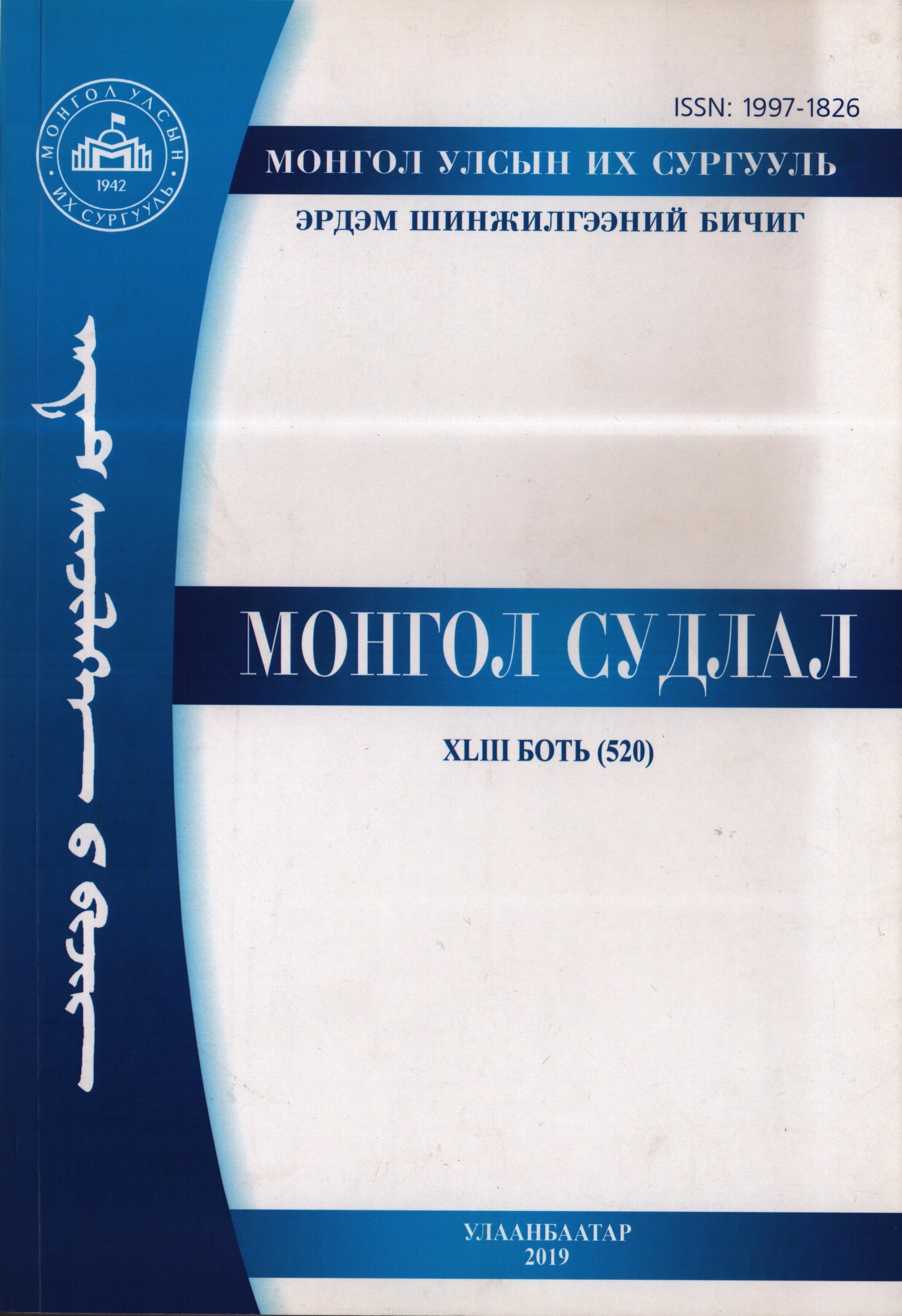Уурлах хилэгнэх үйлдлээр уран дүрийг тодруулах нь
Elucidating literary imagery based on the speech act of anger
Keywords:
хэлэхүйн үйлдэл(speech act), утга зүйн онол(semantic field), уран сайхны дүр(literary image), хэв шинжит дүр(typological image), задлаг хам бүтэц(analytic construction)Abstract
This article, a continuation of the author’s research on such certain speech acts like smiling and crying in Mongolian, examines the typological features of lexical and non-lexical means of expressing the speech act of anger as exhibited by the main protagonists of Tungalag Tamir {The Clear Tamir) by Č. Lodoidamba, a work forever immortalized as the most famous novel of modem Mongolian literature. Specifically, this article identifies verbal and non-verbal instances of the verb uurla- ‘to be angry’ and its synonyms, as well as instances of laughter and cry in this famous novel.
Examining the instances of anger of the protagonists of the novel Tungalag Tamir and their logical relations and the development of the characters as exhibited in the beginning, plot, conflict, resolution, and ending of the novel, can be analyzed as follows:
Connecting instances of the protagonists’ anger with their specific character traits and typological features, as well as with the reasons for their anger, reveals the following interesting grammatical patterns:
- Verbal root + -n + uurla- as in: buximdan uurlax and xardan uurlax.
- Verbal root + -tal4 + uurla- as in: xagartlaa uurlax.
- Noun root + -tai3 + uurla- as in: duu suugiii uurlax and ucirgiii uurlax.
- Phrase + uurla- as in: niidn’tataldan uurlax andxomsgoo zangidan uurlax.
- Uur + verb as in: uur n’bagtajyadan badrax; uur n’genet buclax; uur n’delberen satax\ uur ucaar bolox\ uur buximdlaa darax; and uur n ’xiirc bacimdax
- Other specific phrases used by the author, such as: uur omog gald, orson dar’sig owolzon asax; ix omog n ’badrax; buximdlin bogloo n ’sulrax
When one is angry, the most noticeable changes are the changes in their face. For example, caraid turner garax; carai minciin ulaix; carai n ’xtiren bolox etc.
In addition to the face, the movement and changes of other body parts—such as the eyes, eyebrows, lower lips, and teeth—also strongly express anger. For example, eyebrows: xomsgoo siirtei zangidax; xdmsdg n ’zangirax; xdmsdg n ’musgiran erclex etc;
lower lips: xomxiigdd zuux etc.;
teeth: slid zuux; siidee zuun xorsox etc.;
eyes: xorsoltoi niideer xarax; niid n ’ xorsol jigsliin galaar ergeldex; xawxand orson cono alaxaar irsen xiiniig xarj baigaa niideer sirtex; dogsin niideer sirwej xarax, sirwex; niidend n ’ gunig buximdal todorxoi etc.;
lower lips and lower teeth: sazuuraa zuux etc.
It can also be expressed with one’s voice and speech sounds. For example: biidiiiin duugaar zandrax; xasgirax; biidiiiin borgil duugaar genet xasgirax; buximdan muuxai xasgirax; zandran ucaarlax; muuxai iigeer ziixex etc.
In addition to changes in one’s face, gestures and the poses of one’s body also function to express emotions. For example: xdds saxruulan agsrax; bagtran duugiii bolox; xuruugaa ciclen dairax; nudargaa samlax; sawxaa omnox sireen deer tas xiitel tawix; moroo ugz tatan ogcom ergex; xorsoltoi bogood jigsilteigeer canga ineex etc.
In the novel, the verb uurla- ‘to be angry’ and its near-synonyms appear with the following frequencies: uurlax (16 times), buximdax (13 times), ucaarlax (4 times). In the novel, these words express not only anger but are also actively used to denote other anger-related speech acts such as resent, disgust, loathing, scolding, and abhorrence.
Within the sphere of our series of research on the specific forms of modem Mongolian speech acts, we have examined the instances of smiling and laughter, crying, and anger as expressed by the main characters of the novel Tungalag Tamir, arriving at the specific conclusions in terms of their expression of these emotions.





